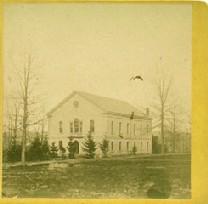

Barrett Hall --Amherst College Archives
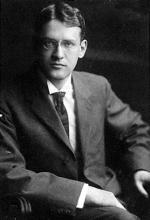
Henry Carrington Lancaster--
Amherst College Archives
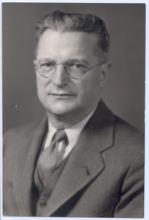
Horatio Elwin Smith --
Columbia University Archives -
Columbiana Library

Geoffroy Atkinson--
Amherst College Archives
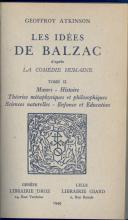
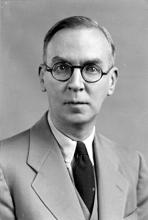
George B.Funnel--
Amherst College Archives

Frederick King Turgeon--
Amherst College Archives

Reginald Foster French--
Amherst College Archives
In the fall of 1895 Edwin A. Grosvenor was awarded the title of "Professor of European History" and was replaced by William Stuart Symington, the first Professor of Romance Languages to hold a Ph.D. in the field upon arrival at the College.18
Under Symington, the program in Romance Languages continued to flourish. At the turn of the century, French and German were still required of all students, who could elect, in addition, to study two years of either Spanish or Italian. The advanced courses in French covered the literary tradition from the seventeenth century through the nineteenth. Students of Italian could study selected texts from the nineteenth century as well as Dante, the Humanists and Renaissance Literature. 19 The Italian courses proved to be so successful that a second position in Romance Languages was established in 1900, which was filled by Arthur Henry Baxter, a Johns Hopkins graduate, who had written his doctoral thesis on poetic meter in Italian poetry. Baxter taught introductory French at the College in addition to filling his responsibilities in Italian.
In 1900 the College adopted foreign language admission requirements defined by the Modern Languages Association. These prescribed that if a student were to offer at admission an elementary proficiency in French, he should have taken two years of it during secondary school. Those who presented advanced proficiency were to have read 400 to 600 pages of materials drawn from a standard list of French literary texts (pp. 39-40). In addition, advanced students of French needed to prove at the entrance exams that they could accurately take French dictation and that they could recite from memory passages that were taken from the materials that they had prepared for the exams (p. 40). Students who sought the Bachelor of Arts degree could present elementary proficiency in one foreign language and advanced proficiency in another (p. 43). Bachelor of Science candidates were required to present elementary proficiency in two languages from among French, German and Latin. By graduation, B.S. degree recipients were to have completed at least two years of college-level work in both French and German (p. 67).
In 1903 Symington suddenly resigned after an incident during which an allegedly drunken janitor disrupted his class. The Governing Board of the College elected not to discipline the janitor, who had been an employee for several decades. The Amherst Student noted how unfortunate it was to lose Professor Symington, since the standard of French then stood "as high, if not higher than any other course in college."20 Symington changed careers, studied the Law, and eventually became a judge in Maryland.
The loss of Symington threatened the quality of the program. The College responded by hiring a candidate who was already deserving of the rank of Associate Professor. William Albert Nitze, a 1902 graduate of Johns Hopkins and an expert in Old French literature, had already published his thesis on the sources of the Perlesvaus. Nitze spent five years at Amherst College before moving on to the University of Chicago, where he would become one of the preeminent scholars of Old French literature in his generation, writing and editing some sixteen books, primarily on medieval topics. During his tenure at the College, seniors studied Old French literature in the original. Juniors read texts from the Romantic period and classics of French theater.
A year after Nitze's arrival, the College renovated Barrett Hall specifically to house the departments of modern languages, a facility where the current French, Spanish and German departments still reside.21 That same year Nitze was joined on the faculty by a research collaborator who had assisted him in preparing an edition of Le Cid by Corneille. Stanley Leman Galpin, a Yale Ph.D., was a specialist in allegorical works that were written in Old French and Provençal. Galpin would teach French at the College until 1916.
Under the guidance of Galpin and Nitze, the students founded in 1904 the "Romance Club". A precursor to today's French and Spanish houses, this club was dedicated to developing conversational skills in romance languages. French, Spanish and Italian were the only languages permitted in the Club Room. Like modern-day French House residents, members performed plays and invited distinguished foreigners to lecture in their native tongue (p. 82).
The program in romance languages must have been popular at the time. By 1905 twelve semesters of courses in French were available (pp. 70-71). This implies that many freshmen arrived at the College with an advanced knowledge of the language and elected to study French at the most advanced levels. Moreover, the curriculum continued to feature three full years of both Spanish and Italian, which the students could begin to study as sophomores (p. 71). By the end of the program, Italianists were expected to read Dante, Boccaccio and Ariosto. Students of Spanish read Cervantes, Calderon, and Lope de Vega. By the time Nitze departed, French was the most highly enrolled foreign language among those taught at the College with 45% of the student body registered in its courses.22
Henry Carrington Lancaster (Ph.D., Johns Hopkins) was hired to replace Nitze in the fall of 1907. Two years later, William Averill Stowell, another Hopkins graduate and an expert in Old French language, was brought in to help staff the expanded program in Romance Languages. Baxter, Galpin, Lancaster and Stowell all taught various sections of French. In addition, Galpin and Stowell taught what must have been an increasingly popular program in Spanish. Baxter covered the courses in Italian as well as one course in Renaissance Art. Lancaster would leave in 1919, having been called back to Johns Hopkins as Chair of the Department of Romance Languages. Before retiring, he would write and edit some twenty-six books on French literature and would serve for thirty years as the editor of Modern Language Notes, one of the most distinguished journals in the field.
In 1910, when Amherst College professors numbered only thirty-seven in all, four of them were dedicated to the teaching of romance languages (pp. 9-14). That year substantial changes to the College curriculum were instituted. Amherst students were introduced to the notion of a "major," which consisted of six courses in one field of study.23 Each student was to elect three majors and one minor, which consisted of four courses (p. 77). All told the combination of the majors and the minor accounted for more than half of the total number of courses needed to complete a degree. The Dean's report for 1911, filed by George D. Olds, Dean of the Faculty, listed French as the second most popular major at the College after English.
Beginning with the class that matriculated in 1911, all students were obligated to demonstrate reading knowledge in both German and a romance language with only one exception. Those who presented Greek at the time of admission could elect to demonstrate reading knowledge in either a romance language or German (p. 73). (As might be expected, these degree requirements seem to have had an effect on enrollment. 50% of the study body was enrolled in French courses that year. 32% were enrolled in German, while the same percentage took Latin.) 24
By 1915 the students were no longer required to triple major. 25 But all of them had to double major (p. 55). The nature of the curriculum that was offered at the time implies that the program in French was quite healthy. The courses were very advanced and introduced students to almost the entire literary tradition. The foreign language admission requirements were so strict that those who presented French could be expected to enroll in advanced literature courses from the start of their academic careers. Freshmen read classics from the seventeenth to the nineteenth centuries. Sophomores took a course in the history of the Novel. Juniors studied the "contemporary novel" and nineteenth-century drama. Seniors took a course entitled "Literary Monuments of Old and Modern French" (pp. 87-88).
Presumably during this period, secondary school programs in Spanish were beginning to develop. In 1917 applicants could choose to present Spanish as one of their modern languages at the entrance examinations for the first time (pp. 32, 50). The material that was to be prepared was analogous to the requirements in French that were prescribed by the MLA. 8% of the student body was enrolled in Spanish that year.
The years of the Great War witnessed some instability in staffing, as Galpin, Lancaster and Stowell left the Department and were replaced by interim instructors. The most notable of these was Madeleine Utter, who spent academic year 1918-19 teaching French and who was the first female instructor of romance languages at the College. Also of interest that same year was the presence of Louis Landré, the first of many students from the prestigious Ecole Normale Supérieure to spend a year teaching French at Amherst.
After the war, in which he served, only Baxter, a British man known affectionately to his students as "Toby," returned to the Department. In the meantime Horatio Elwin Smith, a 1908 graduate of the College, was hired to teach French literature.26 He had taught at Yale for the previous six years and specialized in the analysis of nineteenth-century texts. He wrote articles on Stendhal, Balzac, Sainte-Beuve and Poe, as well as a book on the literary criticism of Pierre Beyle. In addition, he wrote a textbook on advanced French Composition. Under Smith the curriculum in French would see its first course in "Modern French Criticism," which was dedicated to the writings of Sainte-Beuve, Taine, and Renan.27 Smith would leave Amherst in 1926 to become Chair of Romance Languages at Brown University, before assuming the same title a few years later at Columbia University, where he became the editor of Romanic Review.28
In 1920, Geoffroy Atkinson, a 1913 graduate of Amherst who had spent World War I in a medical corps in France, completed his doctorate at Columbia and was hired as Associate Professor of Romance Languages. His career at the College would span thirty-seven years, during which he would produce several significant works of scholarship. In his teaching he was primarily an eighteenth-century specialist. But he wrote works of criticism of remarkable breadth. He spent the 20's writing four books on the theme of the extraordinary voyage in works from the sixteenth, seventeenth, and early eighteenth centuries. In 1929 he became Dean of the College. Despite his added administrative duties, he published during the 30's an edition of Villon and a hefty tome entitled Les nouveaux horizons de la Renaissance Française. For the decade of the 40's he turned his attention to Balzac, about whom he wrote a five-volume work that appeared in 1950, a year that also saw the publication of a collection of his own poems.
Atkinson would preside over a significant expansion of the Romance Languages Department, despite the fact that the post-WWI era would see the curriculum scale back the offerings in Italian and Spanish to two years each. The French curriculum offered seven year-long courses, the culmination of which was a course in the eighteenth century taught by Professor Atkinson.29 By 1925 the Department numbered four professors and one instructor, all of whom taught French, with Baxter covering Italian on the side. The following year an instructor of Italian and Spanish was hired along with two more instructors of French. This period saw the arrival of Ralph C. Williams, George B. Funnell and Frederick King Turgeon, professors who, with Atkinson, would form the core of the Department through the war years and well into the 1960's. By 1927 the addition of Clarance D. Rouillard, an expert in Renaissance French Literature, brought the number of Professors and Instructors in the Department to seven. The number of faculty dedicated to the teaching of romance languages was close to 9% of the faculty of the College, which in 1927 numbered 78.30 At that time all of the members of the Department taught French. Baxter continued to teach Italian and also taught Spanish. With the help of Williams, who had specialized in Italian at Johns Hopkins, the Department was able to restore the program in Italian to three years by 1929.
Evidence from the catalogs indicates that American secondary schools were improving their preparation of the students' foreign language skills during this period. By 1930 the MLA recommendations, which had been adopted by the College as a standard for admission, extended the years of foreign language study expected of applicants to four (p. 43). The enhanced preparation of College matriculants could be seen in the staffing trends from that period. In 1928 the sections of second- and third-year French that needed staffing counted 12. The same year, first-year French only required 2 sections (p. 71-72). This contrast suggests that most matriculants who chose French as their modern language arrived at the College with a preparation that allowed them to register in courses with advanced standing. In the fall of 1930 the degree requirements included a reading knowledge of either French or German, for which other languages could not be substituted (p. 60). That year the Department needed to staff seven sections of third-year French, a course that included a survey of French literature and advanced French composition (p. 77).31
In the 1930s the curriculum in Romance Languages was one of the most extensive of the College. Eleven distinct courses were listed for French (pp. 76-79). Students could still elect to study Italian for three years and Spanish for two (pp. 89, 101). The requirements for a degree with Honors in French were very rigorous: students were expected to write a thesis and to pass two examinations during their senior year. The first was on their written and spoken French; the second was a three-hour comprehensive exam that tested their knowledge of French Literature and History (pp. 105-106).
In 1933, the year that Stanley King assumed the Presidency, preference in admission was given to candidates presenting a total of five years of foreign language study, an obligation that could only be met by studying two separate languages at the secondary school level (p. 27). Foreign language study appears to have been considered a basic skill, along with expository writing and quantitative skills, the value of which cut across the curriculum. Consequently, it counted among the elementary skills necessary for admission to the College. The 1933 course catalog maintained that "English, mathematics and foreign languages (ancient and modern) are the subjects in which entering students should show proficiency" (p. 27). Under King, however, those languages no longer needed to include Latin.32
The 1930s witnessed dramatic changes both in the size of the student body and in the enrollments in modern and ancient languages. Whereas in 1931, 40% of the student body enrolled in Latin, only 4% did so ten years later. For Greek, in which 7% of the student body had enrolled in 1931, only 1% did so in 1942. German, Spanish and Italian all suffered enrollment attrition by the end of the thirties, perhaps because of the political environment of the time. German dropped from 32% to 19%, despite the reading requirement that created an incentive to study the language. Italian, which had been enrolling approximately 6% of the students, found itself with only 1% in 1942. Although Spanish dipped during the mid-thirties, its enrollment rebounded to 7% of the student body by that same year. Throughout this period, French continued to be the most popular foreign language at the College, even though its percentages dropped from 42% of the student body to 34%.33
In 1937, the year before Baxter retired, Reginald Foster French, a Harvard Ph.D. with expertise in Italian was hired to replace him. Although he spent most of his career taking responsibility for the program in Italian, French also taught courses in French language and literature when needed. At the time of his arrival, freshmen who had offered neither French nor German upon matriculation were required to register for either French or German 1 in the fall of their first year (p. 34 note a). All students were still required to pass the French or German reading requirement in order to qualify for a degree (p. 33). Shortly after Reginald French arrived, Frederick Wilson Jeans was brought into the Department to revive the program in Spanish, which had expired upon Baxter's retirement. Jeans' efforts were presumably a success. By 1942 the Spanish curriculum had grown to include, for the first time, four full years of coursework (pp. 91-92).
During World War II the normal course of the Amherst College curriculum was interrupted. Advanced offerings in foreign languages were pared back as personnel were reallocated to assist in the instruction of Army units training at the College and to assure that the extensive summer programs were fully staffed. Some of the foreign language faculty members were recruited to work for the armed services. Atkinson in particular served in the OSS. Back on campus Army units were offered nine-month training courses in French, German, Italian and Spanish. The language program enrolled 250 soldiers.
The post-war years witnessed an increase in the number of Romance Languages faculty and the creation of incentives for graduates and faculty to study abroad. The John Woodruff Simpson Fellowships were established in 1946, which stipulated that, among other things, an award could be used for "graduate study at the Sorbonne in Paris" (p. 116). The "Sherman Pratt Faculty Fellowships for Study Abroad" were instituted the same year (p. 119). Of the eleven faculty members of the Department in 1946, eight of them taught French, two Spanish and one Italian.34
By the end of the war, interest in languages other than those traditionally taught at the College was growing. The catalog from 1948-49 introduced the first courses in Russian, which were taught by Visiting Instructor Ouroussof and covered one year of study.35
Footnotes:
18 Symington's degree was from the Johns Hopkins University. Montague had earned a doctorate late in life, well into his teaching career. Symington was the father of the eventual US Senator from Missouri of the same name.
19 See pp. 56, 65 and 67 of the 1900-01 Amherst College catalog.
20 Amherst Student, June 23, 1903. Symington was known as a "legend of severity" in the classroom and made quite a contrast with the style of the kindly old Montague (Story, 262). French was quite popular at the time. The enrollment data in the Report to the Trustees of 1903 show 41% of the student body in French courses during the fall term. There were 30% enrolled during the spring term. Italian had 15 students in the fall and 12 in the spring; Spanish courses showed 40 and 38, about 10% of the student body at the time. In 1905, approximately 38% of the student body was enrolled in French. German had higher enrollments than French in both years. This was at a time when there was a language requirement in both German and French. See Report to the Trustees 1903.
21 The renovations cost $11,000, an amount equivalent to approximately $211,000 in 2002 dollars. See Fuess, Story, p. 290.
22 See President's Report 1907-08. Spanish continued to enroll about 10% of the student body. Italian had 15-20 students per semester.
23 This requirement was introduced at a time when all students took five courses per semester. See pp. 73, 77 of the 1910-11 Amherst College catalog.
24 For all the statistical information from 1911, see pp. 6, 16 and 47 of the 1911 Dean's report. It is interesting to note that at the time four of the top five most popular majors were foreign languages: French (18.59% of the total number of majors), Latin (10%), German (7%) and Spanish (1.18%) (p. 48). Moreover, this occurred at a time when there was no grade inflation. Approximately 75% of the grades awarded in Romance Languages were C's and D's (p. 43).
25 Fuess maintains that at the May 7, 1914 meeting of the Trustees, President Meiklejohn proposed a curriculum "in which language study was materially reduced in amount" (Story, p. 315). This remark appears without further elaboration.
26 Smith held a doctorate from Johns Hopkins that was awarded in 1912.
27 See p. 76 of the 1920-21 Amherst College catalog.
28 Smith has the distinction of being the only known faculty member of Amherst College to have been named "Chevalier de la Légion d'Honneur" by the French government.
29 See p. 82 of the 1925-26 Amherst College catalog.
30 See pp. 24-29 of the 1927-28 Amherst College catalog. This was consistent with the original proportions of the faculty from the 1820's when the sole Professor of French and Spanish was one of ten total faculty members at the College. This tradition did not fade until after Atkinson's retirement in 1957. In 1946, for example, eleven of the 123 members of the faculty belonged to the Department of Romance Languages.
31 Since two years of secondary school French were considered the equivalent of one year of College work, students who arrived at the College with four years of study in French could register for a third-year course. A good number of the students registered in these seven sections were probably freshmen who were seeking to demonstrate the required reading proficiency in a foreign language early in their careers.
32 Fuess, Story, p. 343; see also Fuess, King, p. 202. It had been determined that the Latin admission requirements were keeping good candidates from being admitted to Amherst College.
33 A fraction of this change can be attributed to the increase in the size of the student body, which numbered less than 700 in 1931, but approximately 851 ten years later. Over the same period the absolute number of registrations for French courses had actually increased from 271 to 309. Enrollment in German stayed relatively constant, although its percentage of the student body drops for the same reason. The enrollment numbers in French seem only to have been surpassed during this period by English and History. For this data, see Porter's Dean's Reports 1932-42.
34 By comparison, there were at the time four Professors and Instructors of German; seven Professors of Economics; seven Professors of Political Science; and eight Professors of English, who were aided in the teaching of English 1 by eight additional instructors.
35 The program in Russian gradually expanded until a major was first offered in 1966. 3 Russian majors received their degrees in 1968. Studies in Japanese would not begin until 1973. Still in 1981 only two years of coursework in Japanese was available. Chinese was added to the Asian Languages and Literatures curriculum in the fall of 1983. <